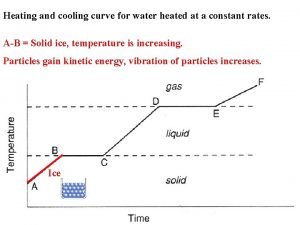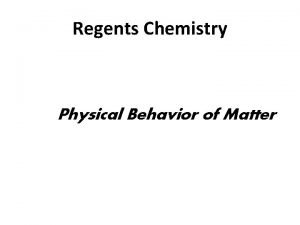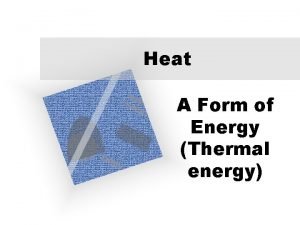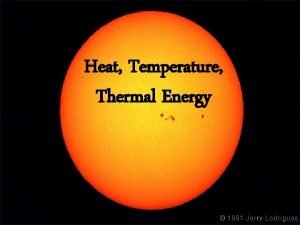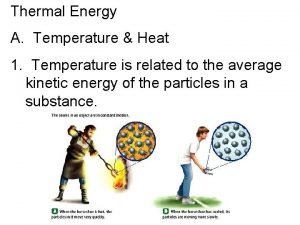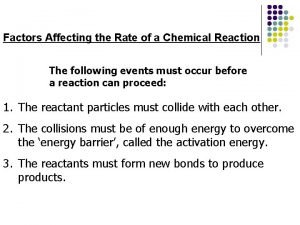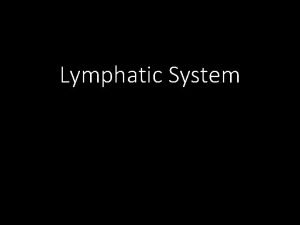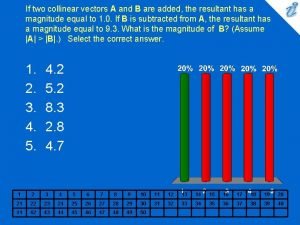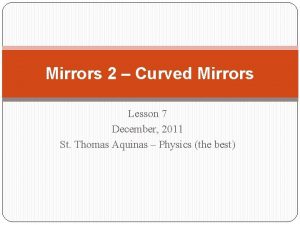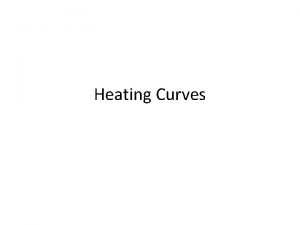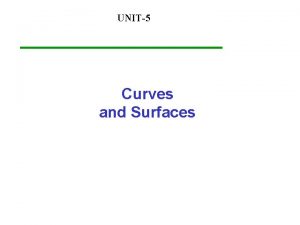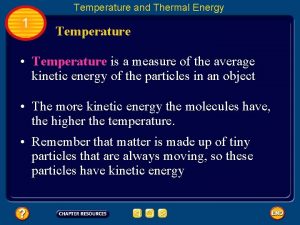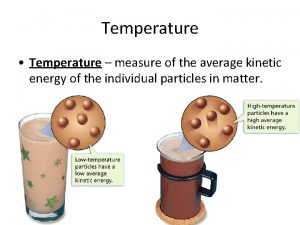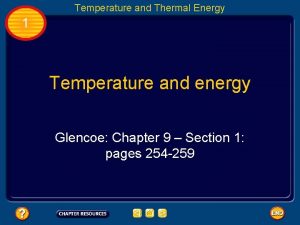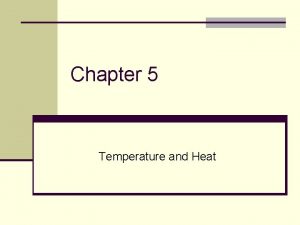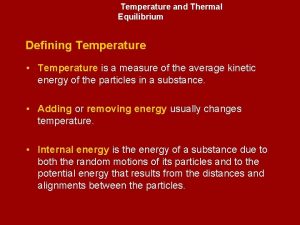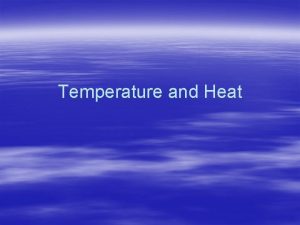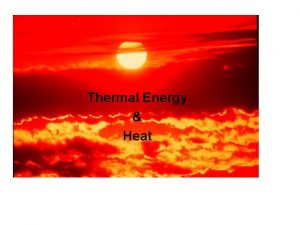temperature Heating curves and DH added energy Heating
































- Slides: 32

temperature Heating curves and DH added energy

Heating curves and DH temperature gas liquid solid added energy

Heating curves and DH melting/ freezing pt temperature gas liquid solid added energy

Heating curves and DH melting/ freezing pt gas temperature boiling/ cond. pt liquid solid added energy

Heating curves and DH melting/ freezing pt gas temperature boiling/ cond. pt melting/freezing occurring here boiling/condensing occurring here liquid solid added energy

How is the total enthalpy change (DH) calculated for a substance whose temperature change includes a change in state?

temperature Dt of solid absorbing energy added energy

temperature DH = m x Csolid x Dt added energy

temperature the energy absorbed as a solid melts becomes potential energy, so no Dt DH = m x Csolid x Dt added energy

temperature DH = DHfus x # mols DH = m x Csolid x Dt added energy

temperature DH = DHfus x # mols DH = m x Csolid x Dt added energy Dt of liquid absorbing energy

temperature DH = DHfus x # mols DH = m x Csolid x Dt added energy DH = m x Cliquid x Dt

temperature the energy absorbed as a liquid boils becomes potential energy, so no Dt DH = DHfus x # mols DH = m x Cliquid x Dt DH = m x Csolid x Dt added energy

temperature DH = DHvap x # mols DH = DHfus x # mols DH = m x Cliquid x Dt DH = m x Csolid x Dt added energy

Dt of gas absorbing energy temperature DH = DHvap x # mols DH = DHfus x # mols DH = m x Cliquid x Dt DH = m x Csolid x Dt added energy

DH = m x Cgas x Dt temperature DH = DHvap x # mols DH = DHfus x # mols DH = m x Cliquid x Dt DH = m x Csolid x Dt added energy

DH = m x Cgas x Dt temperature DH = DHvap x # mols DH = DHfus x # mols DH = m x Cliquid x Dt DH = m x Csolid x Dt added energy

The DH of any substance being heated will be the sum of the DH of any Dt occurring plus DH = m x Cgas x Dt DH of any phase change occurring temperature DH = DHvap x # mols DH = DHfus x # mols DH = m x Cliquid x Dt DH = m x Csolid x Dt added energy

The DH of any substance being heated will be the sum of the DH of any Dt occurring plus DH = m x Cgas x Dt DH of any phase change occurring temperature DH = DHvap x # mols DH = DHfus x # mols DH = m x Cliquid x Dt DH = m x Csolid x Dt added energy

EXAMPLE: What is DH for 10 g water with a total Dt from -20 o. C t DH = m x Cgas x Dt temperature DH = DHvap x # mols DH = DHfus x # mols DH = m x Cliquid x Dt DH = m x Csolid x Dt added energy

temperature EXAMPLE: What is DH for 10 g water with a total Dt from -20 o. C t 50 o. C -20 o. C added energy

What is DH for 10 g water with a total Dt from -20 o. C t use the following values: Cice = 2. 1 J/goc, DHfus H 2 O = 6. 01 k. J/mol, CH 2 O liq = 4. 186 temperature EXAMPLE: 50 o. C -20 o. C added energy

What is DH for 10 g water with a total Dt from -20 o. C t use the following values: Cice = 2. 1 J/goc, DHfus H 2 O = 6. 01 k. J/mol, CH 2 O liq = 4. 186 temperature EXAMPLE: 50 o. C DH 2 = DHfus x # mols 0 o. C DH 1 = m x Csolid x Dt -20 o. C added energy DH 3 = m x Cliquid x Dt

What is DH for 10 g water with a total Dt from -20 o. C t use the following values: Cice = 2. 1 J/goc, DHfus H 2 O = 6. 01 k. J/mol, CH 2 O liq = 4. 186 temperature EXAMPLE: 50 o. C DH 2 = DHfus x # mols 0 o. C DH 3 = m x Cliquid x Dt DH 1 = 10 g x 2. 1 J/go. C x 20 o. C -20 o. C added energy

What is DH for 10 g water with a total Dt from -20 o. C t use the following values: Cice = 2. 1 J/goc, DHfus H 2 O = 6. 01 k. J/mol, CH 2 O liq = 4. 186 temperature EXAMPLE: 50 o. C DH 2=10 g x 1 mol/18 g x 6. 01 k. J/mol DH 3 = m x Cliquid x Dt 0 o. C DH 1 = 10 g x 2. 1 J/go. C x 20 o. C -20 o. C added energy

What is DH for 10 g water with a total Dt from -20 o. C t use the following values: Cice = 2. 1 J/goc, DHfus H 2 O = 6. 01 k. J/mol, CH 2 O liq = 4. 186 EXAMPLE: temperature DH 3 = 10 g x 4. 186 J/go. C x 50 o. C DH 2=10 g x 1 mol/18 g x 6. 01 k. J/mol 0 o. C DH 1 = 10 g x 2. 1 J/go. C x 20 o. C -20 o. C added energy

What is DH for 10 g water with a total Dt from -20 o. C t use the following values: Cice = 2. 1 J/goc, DHfus H 2 O = 6. 01 k. J/mol, CH 2 O liq = 4. 186 EXAMPLE: temperature total DH = DH 1 + DH 2 + DH 3 = 10 g x 4. 186 J/go. C x 50 o. C DH 2=10 g x 1 mol/18 g x 6. 01 k. J/mol 0 o. C DH 1 = 10 g x 2. 1 J/go. C x 20 o. C -20 o. C added energy

What is DH for 10 g water with a total Dt from -20 o. C t use the following values: Cice = 2. 1 J/goc, DHfus H 2 O = 6. 01 k. J/mol, CH 2 O liq = 4. 186 EXAMPLE: temperature total DH = DH 1 + DH 2 + DH 3 = 420 J + 3340 J + 2093 J DH 3 = 10 g x 4. 186 J/go. C x 50 o. C DH 2=10 g x 1 mol/18 g x 6. 01 k. J/mol 0 o. C DH 1 = 10 g x 2. 1 J/go. C x 20 o. C -20 o. C added energy

What is DH for 10 g water with a total Dt from -20 o. C t use the following values: Cice = 2. 1 J/goc, DHfus H 2 O = 6. 01 k. J/mol, CH 2 O liq = 4. 186 EXAMPLE: temperature total DH = DH 1 + DH 2 + DH 3 5853 J = 420 J + 3340 J + 2093 J DH 3 = 10 g x 4. 186 J/go. C x 50 o. C DH 2=10 g x 1 mol/18 g x 6. 01 k. J/mol 0 o. C DH 1 = 10 g x 2. 1 J/go. C x 20 o. C -20 o. C added energy

EXAMPLE: What is DH for 10 g water with a total Dt from -20 o. C t temperature It takes 5853 joules to heat up 10 grams of water from -20 o. C to +50 o. C. DH 3 = 10 g x 4. 186 J/go. C x 50 o. C DH 2=10 g x 1 mol/18 g x 6. 01 k. J/mol 0 o. C DH 1 = 10 g x 2. 1 J/go. C x 20 o. C -20 o. C added energy

EXAMPLE: What is DH for 10 g water with a total Dt from -20 o. C t temperature It takes 5853 joules to heat up 10 grams of water from -20 o. C to +50 o. C. DH 3 = 10 g x 4. 186 J/go. C x 50 o. C DH 2=10 g x 1 mol/18 g x 6. 01 k. J/mol 0 o. C DH 1 = 10 g x 2. 1 J/go. C x 20 o. C -20 o. C added energy

EXAMPLE: What is DH for 10 g water with a total Dt from -20 o. C t temperature It takes 5853 joules to heat up 10 grams of water from -20 o. C to +50 o. C. 50 o. C -20 o. C 5853 J added energy
 Heating and cooling curve of water
Heating and cooling curve of water Physical behavior of matter heating and cooling curves
Physical behavior of matter heating and cooling curves Physical behavior of matter heating and cooling curves
Physical behavior of matter heating and cooling curves Heating and cooling curves
Heating and cooling curves Fusion chemistry phase change
Fusion chemistry phase change Heating curves
Heating curves Dielectric heating formula
Dielectric heating formula Difference between curie temperature and neel temperature
Difference between curie temperature and neel temperature Difference between curie temperature and neel temperature
Difference between curie temperature and neel temperature Difference between antiferromagnetism and ferrimagnetism
Difference between antiferromagnetism and ferrimagnetism Energy energy transfer and general energy analysis
Energy energy transfer and general energy analysis Energy energy transfer and general energy analysis
Energy energy transfer and general energy analysis What is thermal energy formula
What is thermal energy formula Thermal energy in states of matter
Thermal energy in states of matter Heat thermal energy and temperature
Heat thermal energy and temperature Heat flow
Heat flow How are thermal energy and temperature different
How are thermal energy and temperature different How to calculate activation energy from a graph
How to calculate activation energy from a graph How to calculate change in thermal energy
How to calculate change in thermal energy Factors affecting the rate of chemical reaction
Factors affecting the rate of chemical reaction The added value endowed on services and products
The added value endowed on services and products Popularly called lymph glands
Popularly called lymph glands If two collinear vectors a and b are added
If two collinear vectors a and b are added Solid fats and added sugars
Solid fats and added sugars Math promlems
Math promlems Brand is the added value endowed to products and services
Brand is the added value endowed to products and services Brand element criteria
Brand element criteria Space curves
Space curves Creating production possibilities schedules and curves
Creating production possibilities schedules and curves S and j curves
S and j curves Highway curves banked and unbanked
Highway curves banked and unbanked S and j curves
S and j curves Mirror that curves outward and used in convenience store
Mirror that curves outward and used in convenience store
